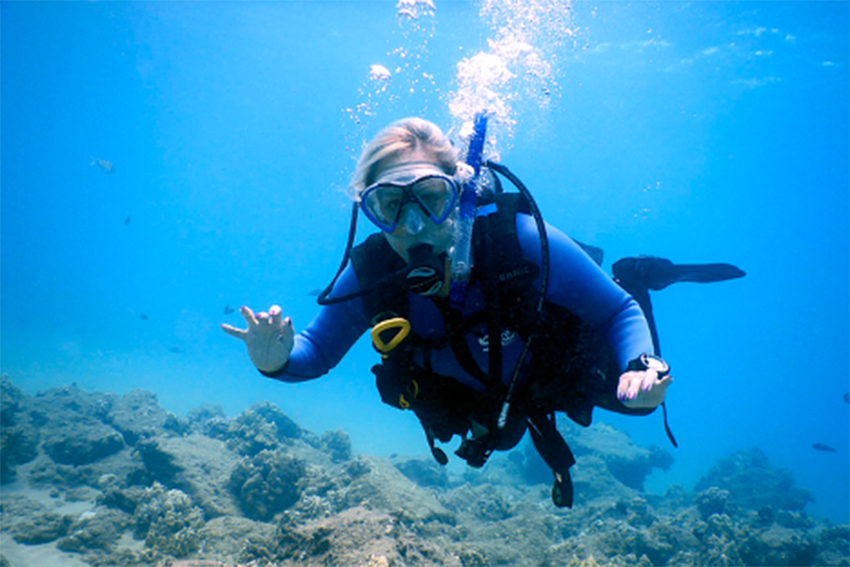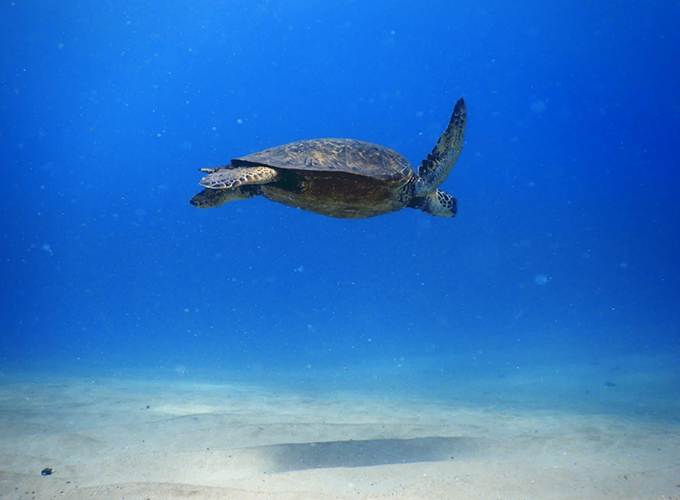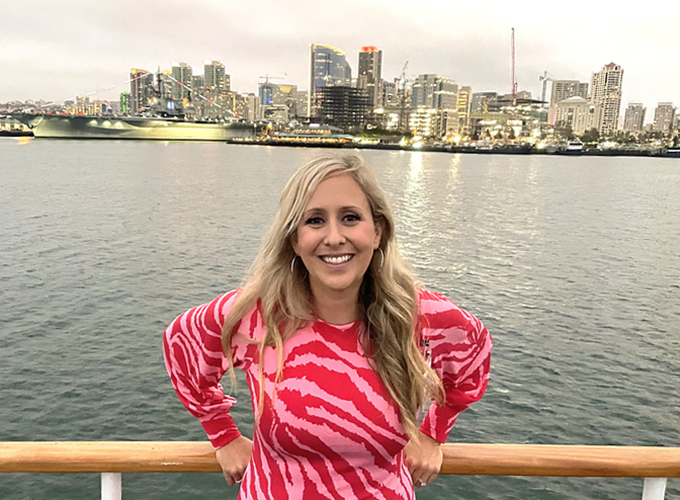18 April 2025
Beyond the Shoreline: What it Means to Be an Ocean Conservationist

As we approach Earth Day 2025 with its theme “Our Power, Our Planet,” this global call for clean energy and collective action feels especially timely.
Protecting the ocean means addressing not just what we consume, but how we think, act, and influence others.
This guide addresses what it means to be an ocean conservationist and how it’s not just about understanding the science of the ocean, but also how to inspire meaningful change.
You don’t need a wetsuit, a coastal zip code, or a Ph.D. in marine biology to be an ocean conservationist. In fact, all of us are already connected to the ocean—whether we realize it or not.
“Even if you’re in a completely landlocked area, your actions still impact ocean ecosystems,” said Frances Lang, ocean educator and instructor for the UC San Diego Division of Extended Studies Ocean Conservation Behavior course. "We're all part of this story.”
The ocean affects all of us. It shapes our weather, influences our food systems, and plays a central role in regulating the Earth’s climate. The ocean’s health is something we should all be conscious of, even if it seems far away.
As we approach Earth Day 2025 with its theme “Our Power, Our Planet,” this global call for clean energy and collective action feels especially timely. Protecting the ocean means addressing not just what we consume, but how we think, act, and influence others.
We spoke with Lang to learn more about what it means to be an ocean conservationist—both officially and casually—and how it’s not just about understanding the science of the ocean, but also how to inspire meaningful change.
Why Ocean Conservation Matters to Everyone
Being an ocean conservationist starts with one simple truth: your daily choices have influence.
“We’re all connected to the ocean—whether we realize it or not,” Lang said. “Even if you’re in a landlocked area, you’ve likely purchased goods that came from the ocean, were shipped across the ocean, or you live in a watershed that drains to the ocean. Your actions and decisions still matter.”
Ocean-related issues like climate change, food security, and public access may feel distant for some, but they affect us all in tangible ways.
Even inland communities are destined to feel the effects of a less healthy ocean. Warming ocean temperatures fuel more intense storms and disrupt global weather patterns. Overfishing and pollution impact the availability and safety of seafood.
Our collective well-being truly depends on a thriving ocean.

Ocean Literacy: A Foundation for Action
To lay the groundwork for conservation, Lang introduces students to the concept of ocean literacy—a framework developed by the National Marine Educators Association and other partners that explains the essential connections between people and the ocean. It’s a tool for both understanding and communicating ocean science.
“It’s not just about knowing facts,” she explained. “It’s about understanding your role in the system.”
Ocean literacy encourages systems thinking and a deeper personal connection to marine environments. It also helps course participants—especially those working in zoos, aquariums, museums, and schools—become more effective educators and advocates for ocean conservation.
Some of the principles of ocean literacy include:
- The ocean and humans are inextricably interconnected – our choices ripple out into ocean systems, and the ocean’s health ripples back into ours.
- The ocean is largely unexplored – which sparks curiosity, a powerful motivator in education and conservation.
- The ocean makes Earth habitable – producing oxygen and regulating climate systems.
- The ocean supports a great diversity of life and ecosystems – a principle that excites Lang the most. “As a scuba diver, I’m just in awe of the diversity of life,” she said. “Wildlife makes our environment so much more interesting—and worth protecting.”
"I’ve had students from the Phoenix Zoo, the Oregon Coast Aquarium, and even international students from Mexico and Canada," Lang shared. "A lot of them are educators in public learning centers, trying to figure out how to engage the public more effectively. The ocean literacy framework provides a very straightforward way of making ocean conservation accessible to everyone."
Behavioral Science Meets Ocean Action
While ocean science is a core part of the conversation, Lang makes it clear: knowledge alone usually doesn’t spark change.
“Even people who care deeply about the ocean don’t always act in ocean-friendly ways,” she said. “That’s why we also focus on behavioral science, to explore what actually helps people shift their habits.”
Important habits for individuals to adopt include being more conscious consumers, reducing overall consumption, and buying reusable or eco-friendly products when possible.
Yet more than simply making a decision to change, Lang also emphasizes the importance of understanding the psychological barriers people face in creating new ocean-friendly habits—and what can be done to lower those barriers.
“Effective campaigns begin with understanding your audience,” she said. “Why aren’t people already doing the desired behavior? What would make it easier or more appealing?”
“The goal is to make sustainable behaviors automatic,” she added. “That’s what creates lasting change.”
As an example, Lang pointed to plastic pollution.
“One of the biggest issues with plastic pollution isn’t demand—it’s supply,” she explained. “People don’t necessarily want single-use plastic. It’s just what’s readily available. So we have to address this culture of convenience, especially in the U.S., and make sustainable options more accessible.”
Another important aspect of behavior change is modeling the desired behaviors in public where they can be most visible.
“Focus on your ecosystem of influence—your family, your community, your organization,” she said. “People are more likely to listen to people they know and trust. If they observe that people close to them are making changes and doing things differently, they’re more likely to join in. People typically want to be part of something that’s growing rather than acting alone.”

From Individual Habits to Systemic Shifts
Lang acknowledges that individual behavior change—though powerful—is only one piece of the puzzle. This is part of the reason why events like Earth Day are so powerful. They are venues for sparking global conversations about clean energy, climate resilience, and ocean health.
"What we do individually matters," she said, "but it’s most impactful when it’s connected to collective and systemic change."
Lang highlights other examples of systems thinking collective action like beach cleanups paired with petition-signing and civic pledges as valuable ways to combine direct action with broader advocacy.
“A lot of these issues can’t be solved by individual effort alone,” Lang said. “We need better infrastructure, better policies, and better systems in place. That doesn’t mean individual action is meaningless—it’s part of the larger ecosystem of change.”
Lang encourages aspiring ocean advocates to also explore policy and civic engagement as valuable ways to scale their impact through voting, community organizing, and influencing institutional practices.
What It Really Means to Be an Ocean Advocate
Ultimately, Lang believes the key to effective ocean conservation is helping people feel both connected to and capable of making a difference.
"It’s easy to feel overwhelmed by how complex and serious these topics are," she said. "But the goal is to feel empowered, not paralyzed. Focus on the issues you can influence—and start there."
Whether you’re redesigning an exhibit, leading a youth group, or rethinking your own daily habits, you don’t need to live near the ocean to protect it. Conservation is something we can all participate in—and this Earth Day 2025 with the theme of “Our Power, Our Planet,” offers a powerful reminder that change begins with each of us.
To learn more about ocean conservation and the role of behavior change in environmental education, consider enrolling in the Ocean Conservation Behavior course offered by UC San Diego Extended Studies. The course is an elective in the Sustainability and Behavior Change Certificate Program.